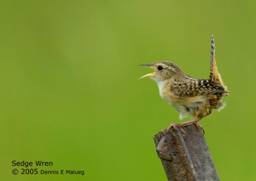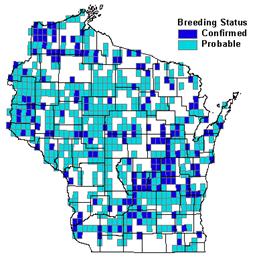Photo by Dennis Malueg


Status/Protection
- Global Rank: G5 Key to global and state ranks
- State Rank: S4B
- WBCI Priority: PIF, State Special Concern
Population Information
The Federal BBS information can be obtained at http://www.mbr-pwrc.usgs.gov/bbs/bbs.html by clicking on Trend Estimates and selecting the species in question. All estimates are for time period (1966-2005).
- Federal Breeding Bird Survey: significant increase
- Federal Breeding Bird Survey (WI): non-significant increase
- Federal Breeding Bird Survey (BCR 23): non-significant increase
- Federal Breeding Bird Survey (BCR 12): significant increase
- WSO Checklist Project: significant increase (1983-2007)
Life History
- Breeding Range: Central Prairie Provinces of Canada southward through the midwestern U.S.; local breeding populations in the eastern U.S. (Herkert et al. 2001).
- Breeding Habitat: Northern Sedge Meadow and Marsh, Southern Sedge Meadow and Marsh, Idle Cool-season Grasses, Idle Warm-season Grasses, Wet-mesic Prairie, Wet Prairie, Forested Ridge and Swale, Open Bog-Muskeg.
- Nest: See Birder’s Handbook.
- Nesting Dates: Late May to mid-July.
- Foraging: See Birder’s Handbook.
- Migrant Status: mid-distance migrant.
- Habitat use during Migration: similar to wintering habitat.
- Arrival Dates: Early May to early June.
- Departure Dates: Early September to mid-October.
- Winter Range: Southern and southeastern U.S to central Mexico along the Gulf of Mexico.
- Winter Habitat: shallow marsh, prairie with dense grasses and sedges.
Habitat Selection
Sedge Wrens require dense stands of tall grass or sedge with abundant litter (Sample and Mossman 1997). In Wisconsin, Sedge Wrens can be found nesting in sedge meadows, wet meadows dominated by reed-canary grass, wet and wet-mesic prairie, and any dense upland grassland. They are especially common in idle Conservation Reserve Program (CRP) fields dominated by brome or warm season grasses. They typically do not occur in drier sites.
Sedge Wrens occupy both small and large meadows/grasslands. Vegetation structure seems to be more important than habitat area in predicting Sedge Wren occurrence (DeChant et al. 2003). Male territories as small as 0.2 ha have been reported (Byrde and Johnson 1991). Areas used by nesting Sedge Wrens tend to be affected by local rainfall conditions, which results in Sedge Wrens being highly mobile with low site fidelity (Kroodsma and Verner 1978). This results in Sedge Wrens occupying habitats in some years and being entirely absent in others.
In winter, this species uses a variety of dense, grassy areas along the lower gulf coast (Herkert et al. 2001). This includes brackish and freshwater marshes and sedge meadows, pine savannas, and other herbaceous habitats.
Habitat Availability
Sedge Wrens nest in most Wisconsin counties and have been detected on more than 90% of Wisconsin’s Breeding Bird Survey (BBS) transects. Large acreages of sedge meadow exist in central and NW Wisconsin and provide some of the most stable and extensive amounts of habitat in Wisconsin. Sedge Wrens are also abundant in warm season grass plantings and herbaceous wetlands on most public hunting areas and CRP fields in the state. Old (no longer flooded) beaver impoundments also provide Sedge Wren nesting habitat.
Many of the large sedge meadow complexes in the central portion of the state are protected as wildlife areas or other public properties and are not expected to diminish in extent. Populations of this species on grass-based agricultural fields in Wisconsin are probably declining as this habitat type has declined. Lands enrolled in conservation programs such as the CRP are a notable exception. Otherwise suitable habitat may serve as a population sink if annual haying occurs in early June.
All factors negatively affecting herbaceous wetlands can be assumed to negatively affect Sedge Wrens. These factors include drainage, development, intensive agricultural development, natural succession, and drought (Ehrlich et al. 1992).
Population Concerns
The Federal BBS trend for Sedge Wrens suggests a slight population increase (Sauer et al. 2005). However; the nomadic nature of Sedge Wrens combined with this species’ late nesting (as late as mid July) (Robbins 1991) makes interpretation of BBS trend data for this species difficult at best. Sedge Wren populations are assumed to be negatively affected by all factors negatively affecting the habitats they prefer. This includes but is not limited to wetland conversion for agriculture and land being withdrawn from CRP.
Recommended Management
Practices that maintain residual vegetation and maintain meadows/grassland will attract Sedge Wrens. Given Sedge Wrens tendency to nest later than many grasslands species, haying, especially in wet meadows should be postponed until later than the mid-July recommendation give for other grassland species (DeChant et al. 2003), whenever possible. Conservation programs designed to promote grasslands and protect wetlands will directly benefit Sedge Wrens.
Woody encroachment will degrade Sedge Wren nesting habitat. Periodic disturbances like grazing, mowing, and prescribed burning can be used to set-back woody encroachment. Where used, rotating prescribed burning, mowing, and grazing to provide a mosaic of untreated nesting habitat may minimize negative impacts of these disturbances on Sedge Wrens.
Research Needs
As the BBS program does not necessarily accurately describe Sedge Wren population fluctuations, an improved monitoring scheme for this species should be developed especially at the periphery of its range. The monitoring scheme should factor in the nomadic nature and nesting chronology of this species (Herkert et al. 2001). A need exists for detailed research on wintering grounds (Herkert et al. 2001) and better demographic data that helps determine the species response to management and restoration efforts.
Information Sources
- David Sample, Grassland Community Ecologist, Wisconsin DNR Research Center, 1350 Femrite Dr., Monona, WI 53716.
- North American Breeding Bird Survey: http://www.npwrc.usgs.gov
- Temple S. A., J. R. Cary, and R. Rolley. 1997. Wisconsin Birds; A Seasonal and Geographical Guide. Wisconsin Society of Ornithology and Wisconsin Department of Natural Resources, Madison, WI.
- Wisconsin Breeding Bird Atlas: http://www.uwgb.edu/birds/wbba/
- Dechant, J. A., M. L. Sondreal, D. H. Johnson, L. D. Igl, C. M. Goldade, B. D. Parkin, and B. R. Euliss. 2003. Effects of management practices on grassland birds: Sedge Wren. Northern Prairie Wildlife Research Center, Jamestown, ND. Northern Prairie Wildlife Research Center Online.
References
- Byrde, M. A., and D. W. Johnston. 1991. Birds. Pages 477-537 in K. Terwilliger, coordinator. Virginia’s endangered species: proceedings of a symposium. McDonald and Woodward Publ. Co., Blacksburg, Virginia.
- Ehrlich, P. R., D. S. Dobkin, and D. Wheye. 1992. Bird in jeopardy: the imperiled and extinct birds of the United States and Canada, including Hawaii and Puerto Rico. Stanford University Press, Stanford, California. 259pp.
- Herkert, J. R., D. E. Kroodsma, and J. P. Gibbs. 2001. Sedge Wren (Cistothorus platensis). In The Birds of North America, No. 582 (A. Poole and F. Gill, eds.). The Birds of North America, Inc., Philadelphia, PA.
- Kroodsma, D. E., and J. Verner. 1978. Complex singing behaviors among Cistothorus wrens. Auk 95:703-716.
- Robbins, S. D., Jr. 1991. Wisconsin Birdlife: Population and distribution past and present. Madison, WI: Univ. Wisconsin Press.
- Sample, D. and M. Mossman. 1997. Managing Habitat for Grassland Birds: A Guide for Wisconsin. Wisconsin Department of Natural Resources: Madison, WI.
- Sauer, J. R., J. E. Hines, and J. Fallon. 2005. The North American Breeding Bird Survey, Results and Analysis 1966 - 2004. Version 2005.2. USGS Patuxent Wildlife Research Center, Laurel, MD
Contact Information
- Compiler: Jenny Herrman, Wisconsin DNR
- Editor: Richard King, Richard_s_king@fws.gov
